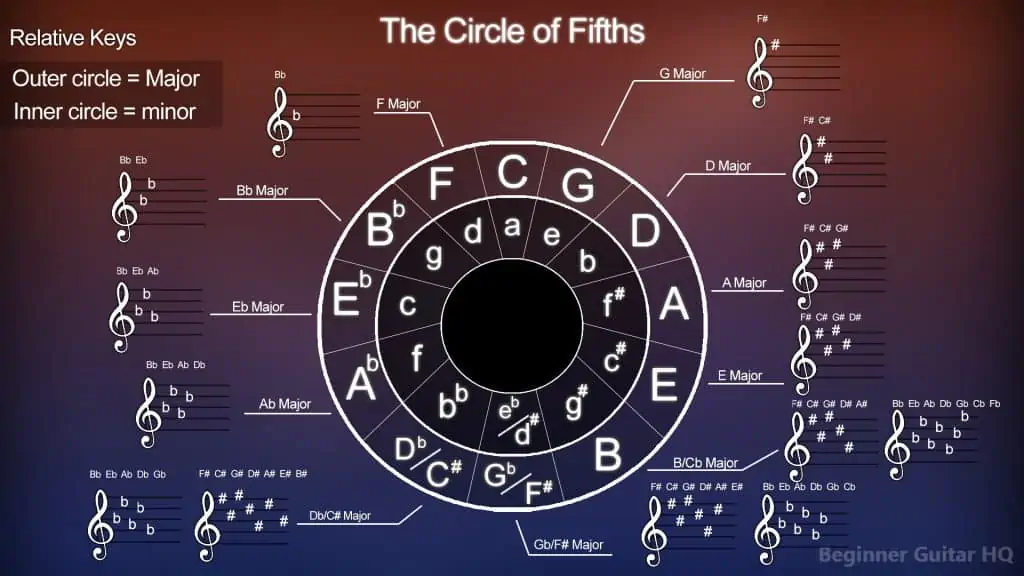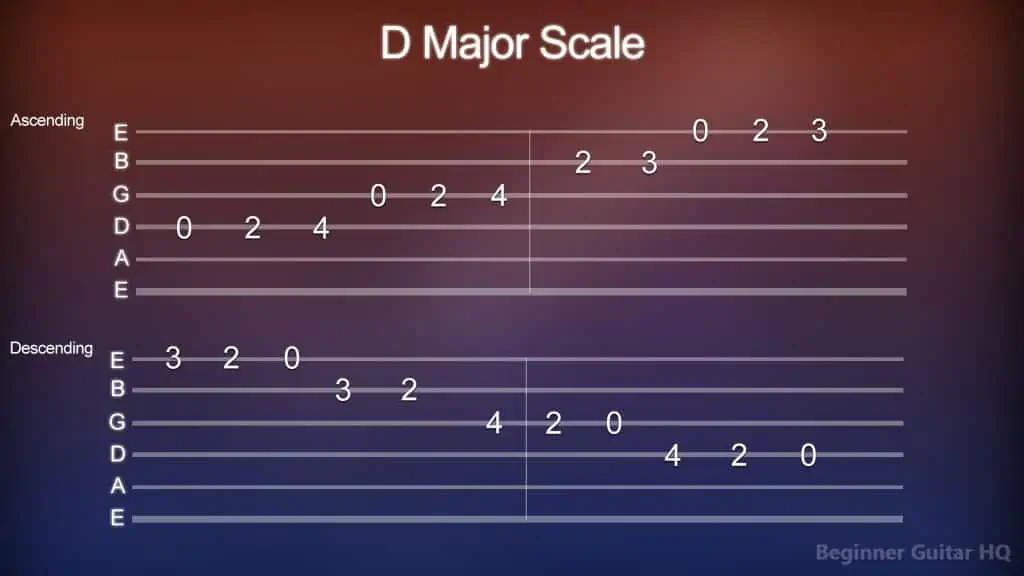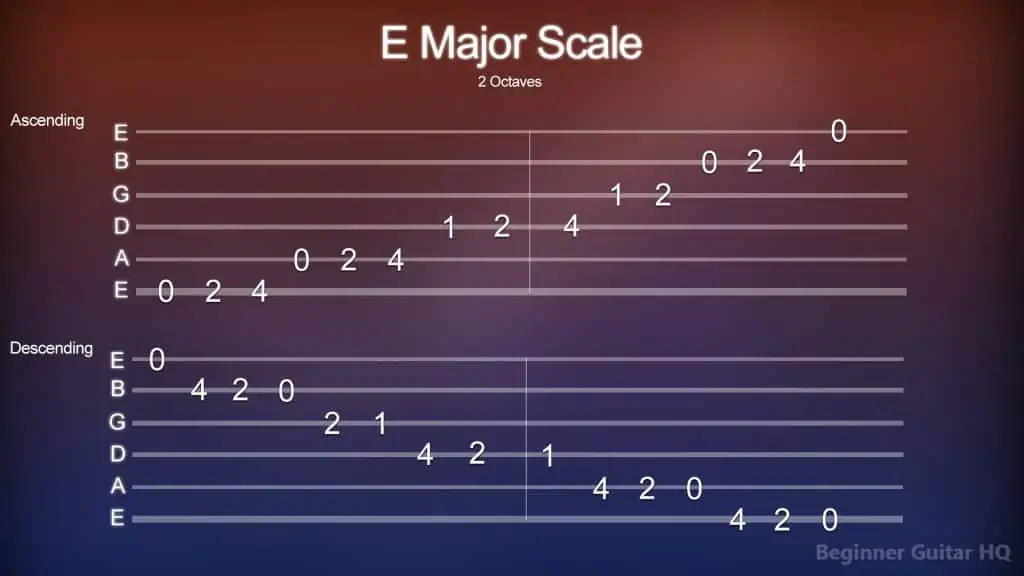As a young and ambitious musician, I can recall one of the fundamental things I learned about playing the guitar; playing the Major Scale. To be more specific it was the C Major Scale, and it was easy, but more importantly, it was fun. Let’s explore it deeper, shall we?
The cover image, displaying the topic and a young man, like you, eager to play guitar!
Contents
What Exactly is a Major Scale?
To sum it up best; within an octave, a Major Scale is a collection of 7 notes played in sequence with the final 8th note being the root note, otherwise known as the tonic of the scale. So for instance, if you are playing C Major, the root of the scale is C. It will begin on C and it will end on C.
The Major Scale, which may also be referred to as the Ionian Mode, follows this sequence of notes:
C – D – E – F – G – A – B – C
It is very simplistic!
But, what exactly MAKES it a Major Scale?
Well, in short: A Major Scale in general is defined by containing nothing but whole steps except for the third to fourth degrees, and the seventh to eighth degrees, which are instead half-steps. This can also be represented as:
W – W – H – W – W – W – H
The W’s represent the whole steps, and the H’s represent the half-steps.
In a minor scale, however, you would follow this pattern instead:
W – H – W – W – H – W – W
These are the formulas used in Major and minor scales.
When we factor in key signatures, C Major is a blank slate, very similar to A minor. This is because they both share no sharps or flats in their key signature. When there are two completely different scales that follow the same key signature, we call them relative keys.
More Information on Scales:
Now, we mentioned how C is the root note of the C Major Scale, but did you know that the other notes have names as well? The names relate to the degree the note falls in the scale.
Diagram of all of the scale degrees within the C Major scale
Tonic
As we covered, the tonic is the root note of the scale. Every scale has one. More importantly, it’s what gives the scale its name. Knowing this alone can help us identify where to begin.
Supertonic
This is the second degree of the scale in C Major. However, not every scale has one. These only occur in diatonic scales. Scales that include five whole steps and two half steps. (A diatonic scale is another variation of a heptatonic scale – a scale containing 7 pitches between octaves.)
Mediant
The third degree of a scale is called the mediant, located half way between the tonic and the dominant. Interestingly enough, mediant derives from the Latin word used for “middle”. And you can find the mediant in the middle of a triad built on the first degree. Pretty cool!
Subdominant
Located just before the dominant on the fourth degree of the scale. The word sub can mean “just below”, which it just so happens that it’s right below the dominant.
Dominant
The dominant is the fifth degree of the scale, and second to the tonic in terms of importance. It was used as a pivoting point for Classical composers to change from the dominant to the tonic for a piece to resolve soundly.
Submediant
The sixth degree of the scale, otherwise known as the submediant shares a similarity with the subdominant in its utilization of the word sub. This is because the submediant is below the leading tone. Not to get mixed up with the mediant.
Leading Tone
Lastly, the leading tone, the 7th degree. A fairly important degree as it is just below the tonic by a half-step, allowing for resolution to the tonic.
Knowing the names of each degree in a scale can help when referring to a specific note within a scale.
Why Learn Scales?
It’s completely okay if you would rather learn a few songs on guitar to jam around with your friends. However, learning scales comes with a lot of nifty benefits to guitarists alike!
A group of guitarists performing at a show, guitarists and bassist alike benefiting from practice.
Firstly, it will help you become a better guitarist and a better musician in general. In terms of improving playing ability, there are a lot of good practice methods involving scales to improve dexterity and overall clean playing technique. Learning scales can also improve your knowledge around music theory, allowing you to take it to other avenues and perhaps other instruments! The world is your oyster.
On the topic of music theory, or for this article’s sake, guitar theory, it can help you improve your songwriting/music composition abilities. If you take the time to not only learn how to play the scales, but truly grasp them, then you can make use of them when it comes to writing music. If you’re playing in a certain key, you will know which notes to use, for transition, adding resolve, for buildup.. Etc. Learning intervals, and iconic songs/pieces of music that use them can help further your understanding on how this works.
It can aid you in improving your improvisation techniques. When learning to improvise a melody, knowing scales outside of knowing key signatures can be helpful! There are a lot of different types of scales to choose from:
- Pentatonic – Contains 5 notes per octave. Commonly used in Asian music.
- Hexatonic – Contains 6 notes per octave. Commonly used in Western Folk music.
- Heptatonic – Contains 7 notes per octave. Commonly used in Western Art music.
- Octatonic – Contains 8 notes per octave. Commonly used in Jazz and Moderen
Classical music.
- Nonatonic – Contains 9 notes per octave. Used in Blues music, as a different variation
of the Blues scale, with more chromatic characteristics.
- Chromatic – Contains 12 notes per octave.
Jazz guitar improvisation is a little bit of a special case. The idea there is that you play “wrong notes” outside of the key in order to build tension, and then by playing “correct” notes within the key as a release. It takes a lot of practice and preparation in order to pull it off correctly.
You might gain further insight into how chords are built. For instance, let’s take a look at the C Major scale. By combining the First, Third, and the Fifth Degrees of the scale, (the tonic, mediant, and the dominant) we can make what’s known as a Major triad. A triad is a type of chord formed from three notes.
As long as you know where the tonic is of the scale, you can form major chords by playing the (1 – 3 – 5) degrees consecutively. You may also decide to practice triads on each note within the scale, which would make for a fun challenge!
C Major Scale Tabbed Out
The Notes of C Major
In C Major, the notes are as follows:
C – D – E – F – G – A – B – C
There are no sharps or flats to be concerned with, which makes this the ideal scale to learn as a beginner.
If you are familiar with tablature, a form of reading music for guitar using numbers instead of staves, here is a diagram to show the notes used in C Major:
Diagram showing the tablature for the C Major Scale.
If you are unfamiliar with tablature, reading it is quite simple and doesn’t take too long to learn!
Firstly, we have six lines, each representing the six strings of the guitar. These notes are as follows, E, A, D, G, B, and E. What you’ll see next is that on the A string there is a number 3. The number indicates that on the A string, you are to play the 3rd fret. This is the first note of the scale, the tonic of the C Major Scale, C.
On the next string, the D, you will see the number 0. This indicates that the note to be played on the D string is to be an open note. An open note, in other words, is a string that is plucked or strummed as is, and not fretted. Following that, you have the number 2 also on the D string, which means you have to play the 2nd fret next.
You should get the idea by now!
When you hit the top of the scale, try seeing what it’s like playing it backwards!
The Circle of Fifths
The Circle of Fifths is a very helpful tool that can help musicians understand different key signatures and utilize them to their full potential!
There are plenty different situations that might call for you to consult the circle of fifths. Situations where you need to transpose a certain melodic phrase to a higher or lower pitch, and need to know which notes are affected as a result. Perhaps you might even want to improvise a melody and you know the key you’re playing in, but not which notes are affected by that key.
The circle of fifths can help in a huge way to make sure you are playing the correct notes within the key signature.
Diagram displaying the Circle of Fifths. Each key signature and its relative key are shown as well.
When you look at the circle of fifths, you will see that there are capitalized letters on the outside, and a mini chart with sharps and flats next to them. The letter represents the key signature and the chart next to it shows each note that is affected by the key signature, and in what way. So if the # is on the F that means that every time you are dealing with an F note, it’s to be raised by a half-step. The opposite would occur if it were a b, in which case it would lowered by a half-step.
Now, the letters circling clockwise might seem random at first glance, but there is a good reason behind it. Let’s think of the circle of fifths like a clock. At 12 o’clock you have your C, the root of C Major, containing no sharps or flats. Now, let’s advance by five notes:
C – D – E – F – G
We landed on G. In G Major we have one sharp, the F Sharp. Let’s advance another five notes:
G – A – B – C – D
Now, we’re on D, and the key is now D Major. This contains two sharps, F Sharp, and C Sharp. Let’s advance another five notes:
D – E – F – G – A
We’re on the A note now. The key is A Major, containing three sharps, F, C, and G Sharp.
Are you sensing a pattern?
As you can see the reason it’s called the circle of fifths is because of the five-note gap between each key signature. You may also notice that the sharps keep increasing by one every five notes, but there is another pattern that you might have missed. In G Major we had one sharp – the F Sharp. Let’s take the note F back by four notes:
F – E – D – C
We just landed on C. This happens to be the next note in the following key signature, the key of D Major! Let’s go back another four notes:
C – B – A – G
Now, we’re on G. In the key of A Major, that is the third sharp. F, C and G.
The key takeaways:
- C Major has no sharps or flats.
- To figure out the name of the following keys, starting from C move forward five notes.
- G Major has one sharp: F sharp.
- To figure out the key signature, move backwards four notes from the last sharp added.
Alternate Method:
If you would rather use a different method of remembering the order of sharps added to each key signature, as opposed to counting back by four notes each time, then all you need to know is this simple acronym:
F – C – G – D – A – E – B
Father Charles Goes Down And Ends Battle
Associate each letter on the circle of fifths with a number.
C – 0
G – 1
D – 2
A – 3
E – 4
B – 5
F# – 6
C# – 7
The numbers represent how many sharps are added. Now, if you needed to find, let’s say, B Major, that’s the number 5. Sound out the acronym:
Father, Charles, Goes, Down, And
That’s five, and each word spoken represents a sharp used in that key signature. So you’d have F, C, G, D, and A sharp.
On the other end of the spectrum we have our flat keys. These follow the same pattern we discussed prior to this method, but to remember each note used, we use the acronym from earlier, only backwards:
B – E – A – D – G – C – F
Battle Ends And Down Goes Charles Father
Starting from C going counterclockwise, each number is representing a letter:
C – 0
F – 1
Bb – 2
Eb – 3
Ab – 4
Db – 5
Gb – 6
Cb – 7
So for example: if you’re looking for the flats used in Db Major, you have the number 5:
Battle, Ends, And, Down, Goes
So the flats in the key of Db Major are B, E, A, D and G.
In reality, you only need to learn one half of the circle of fifths to figure out the rest. For instance knowing that B Major has five sharps, means that Bb Major will have two flats, equaling seven. E Major has four sharps, so that means Eb Major will have only three flats, equaling seven. C Major has no sharps or flats, so naturally, C# and Cb Major will have seven sharps and seven flats, once again equaling seven.
Other Major Scales
Earlier, we had gone over the C Major Scale, and how it’s formed. Now that we know more about key signatures, let’s cover some more scales, starting from A Major we’ll work our way to G Major. (The right half of the Circle of Fifths).
Diagram showing the ascending/decending tablature for the A Major Scale.
Diagram showing the ascending/descending tablature for the B Major Scale.
Since, we’ve covered the C Major scale earlier, we’ll be skipping over it.
Diagram showing the ascending/descending tablature for the D Major Scale.
Diagram showing the ascending/descending tablature for the E Major Scale.
Diagram showing the ascending/descending tablature for the F# Major Scale.
Diagram showing the ascending/descending tablature for the G Major Scale.
How to Use Scales in Daily Practice
Using scales in daily practice can serve a lot of benefits to your playing ability. When starting out, you may find it difficult to fret notes with more than your index or middle finger. However, constructing a routine that includes scales can help build finger strength, dexterity and contribute to muscle memory.
There are a couple of methods to practice scales:
The Up and Down Method:
This is the best way to practice a scale when you’re first learning how to play it. You start from the root note of the scale, and play it upwards until you hit the peak, then you play it back down to the root again.
The Build Up Method:
Once you’re more comfortable with the scale, I find that the build up method can help you correct sloppy playing technique. If you were playing a C Major scale using this method, you would start by playing the C note, go up to D, then back to C, then D, and E, then back down to C, then D, E , and F, then back down to C and so on. If you prefer the scale degrees, follow this example:
1 – 2 – 1 – 2 | 3 – 2 – 1 – 2 | 3 – 4 – 3 – 2 | 1 – 2 – 3 – 4 |
5 – 4 – 3 – 2 | 1 – 2 – 3 – 4 | 5 – 6 – 5 – 4 | 3 – 2 – 1 – 2 |
3 – 4 – 5 – 6 | 7 – 6 – 5 – 4 | 3 – 2 – 1 – 2 | 3 – 4 – 5 – 6 |
7 – 1* – 7 – 6 | 5 – 4 – 3 – 2 | 1 – x – x – x |
Note: The 1* is actually a C note, just an octave higher than the starting note.
Playing Thirds:
This can help you change up the pattern a little bit while staying in key, keeping you on your toes! This consists of playing intervals of a 3rd. A Major 3rd interval consists of two notes gapped by two whole steps. This is equivalent to playing C then E. The way that this exercise is done is by playing a 3rd, which skips over a note in the scale. Then you play the note you skipped and play a 3rd from there! This can help get your creative juices flowing when you get used to these different notes!
Using a Metronome
Practicing with a metronome is highly recommended to improve your timing and clean up your playing technique. Of course, little things like posture, drilling chords, and picking techniques can all factor in as well. You will typically want to set the BPM (Beats Per Minute) fairly slow when starting out. Of course, ramping up the tempo will be more of a challenge, but the goal isn’t to play as fast as possible, it’s to play as clean and proper as you can. When playing, every note matters and should be treated as such.
From there, you may choose to keep the tempo slow but try alternative methods like playing double time, (2 notes per tick), or playing triplets. The important thing is that you make it fun and challenging for yourself.
The following video can help you improve your practice routine so that you can make the most of these tips:
Subtle tricks and habits to improve your playing, while working on scales!
Remember to Rest!
Taking a short break never hurt anyone! If you feel fatigued, or a building frustration towards something you can’t play, a 15 – 30 minute break can be all you need to get back into the zone.
If you decide to take longer breaks, a couple of days for instance – you don’t have to worry about losing your ability to play. It’s almost like riding a bike, your muscle memory will help you pick up where you left off. The only thing that truly suffers is the callouses that you have developed over time.
Conclusion
Major scales are a rudimentary side of music, and can help you lay the foundation to achieving more on your instrument. It’s highly encouraged that you not only learn how to play them but understand their place in music as a whole! Now you’re on your first step to making the most of them. Rock on!












